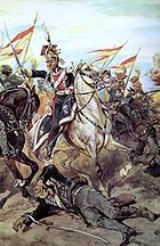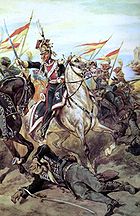
Chevau-légers
Encyclopedia
The Chevau-légers was a generic French name for several units of light cavalry, roughly similar to lancers in the armies of other states during the Napoleonic Wars
. Perhaps the most famous of all such units were the Polish 1st Light Cavalry Regiment
of the Guards and the French 2nd Light Cavalry Regiment of the Guards. In later periods of the conflict also the Polish 3rd Light Cavalry Regiment of the Guards was formed.
 Their history began in the late 15th and early 16th centuries, when the heavy cavalry
Their history began in the late 15th and early 16th centuries, when the heavy cavalry
forces of the French Compagnies d'Ordonnance were undergoing a massive structural reorganization. Initially, the companies combined the gendarmes (fully armored men-at-arms) along with lighter coutiliers and "archers" in the same mounted formation, with the better-armored men forming the foremost ranks. However, as time passed the lighter horsemen were increasingly separated into independent formations of "medium" cavalry, bearing lighter armor and much shorter lances than the gendarmes. These lighter formations eventually gained the name of chevaux légeres. A similar development also happened in the organization of the Austrian and Spanish cavalry with the growth of caballería ligera formations.
Napoleonic Wars
The Napoleonic Wars were a series of wars declared against Napoleon's French Empire by opposing coalitions that ran from 1803 to 1815. As a continuation of the wars sparked by the French Revolution of 1789, they revolutionised European armies and played out on an unprecedented scale, mainly due to...
. Perhaps the most famous of all such units were the Polish 1st Light Cavalry Regiment
Polish 1st Light Cavalry Regiment of the Imperial Guard
The [Polish] 1st Light Cavalry Lancer Regiment of the Imperial Guard was a formation of Polish light cavalry that served Emperor Napoleon during the Napoleonic Wars.The Regiment, as part of Napoleon's Imperial Guard, fought in many battles,...
of the Guards and the French 2nd Light Cavalry Regiment of the Guards. In later periods of the conflict also the Polish 3rd Light Cavalry Regiment of the Guards was formed.

Cavalry
Cavalry or horsemen were soldiers or warriors who fought mounted on horseback. Cavalry were historically the third oldest and the most mobile of the combat arms...
forces of the French Compagnies d'Ordonnance were undergoing a massive structural reorganization. Initially, the companies combined the gendarmes (fully armored men-at-arms) along with lighter coutiliers and "archers" in the same mounted formation, with the better-armored men forming the foremost ranks. However, as time passed the lighter horsemen were increasingly separated into independent formations of "medium" cavalry, bearing lighter armor and much shorter lances than the gendarmes. These lighter formations eventually gained the name of chevaux légeres. A similar development also happened in the organization of the Austrian and Spanish cavalry with the growth of caballería ligera formations.

